The 2014 LCGC Awards (Part 1)
The 2014 Lifetime Achievement in Chromatography Award is granted to Fred E. Regnier. Here we chart his career and accomplishments.
The seventh annual LCGC Awards continue the time-honoured tradition of celebrating the careers of outstanding chromatographers. The 2014 Lifetime Achievement in Chromatography Award is granted to Fred E. Regnier. This is the first of a two part feature in The Column charting the career and accomplishments of the awardees.
One of the greatest aspects of the LCGC Lifetime Achievement in Chromatography Awards is that it presents us with the opportunity to appreciate the legacy and scientific impact of our winners. The passion and insight these scientists offer the community cannot easily be expressed, but everyone we interview gives resounding comments in that regard. For Fred E. Regnier, the passion, legacy, and scientific impact are just a few of his many achievements in a life-long scientific journey.

(PHOTO CREDIT: SCIENCE PHOTO LIBRARY - MEHAU KULYK/GETTY IMAGES)
Regnier's path to chromatography did not start in the usual fashion. He says that he came to science "through the back door". "Getting into science didn't occur to me until I was out of college," he adds. In fact, he claims he only started college as a way to get out of working outside in the cold Nebraska winter. Despite his professed lack of interest in science early on, as an undergraduate at Nebraska State College (Nebraska, USA) Regnier had a triple major in physics, chemistry, and mathematics — quite an undertaking! It was during those undergraduate years that Regnier first came across separation science — while shelving books at the library on chromatography and electrophoresis. Those subjects clearly captured his interest; Regnier's undergraduate thesis was on paper electrophoresis of amino acids. After graduating from Nebraska State College in 1960, Regnier went on to get his PhD from Oklahoma State University (Oklahoma, USA) in 1965. The focus of his doctoral dissertation was the biosynthesis of terpenes and pheromones.

Fred E. Regnier
Regnier went on to do postdoctoral research at Oklahoma State University in 1965, the University of Chicago (Illinois, USA) from 1966 to 1967, and Harvard University (Massachusetts, USA) in 1968. That work at Harvard, under the direction of Ed Wilson and John Law, focused on the identification of insect hormones and pheromones. He built a high performance liquid chromatography (HPLC) system to purify trail pheromones from 100-lb bags of fire ants and also did work with gas chromatography (GC) and mass spectrometry (MS).
Following his postdoctoral research, Regnier took an assistant professor position in the biochemistry department at Purdue University (Indiana, USA), where he began a long-lasting professorship that would span more than four decades. He was promoted to associate professor of biochemistry in 1971. In 1976 he was promoted to associate director of the agricultural experiment station and then to full professor of biochemistry. In 1990 his title changed to a professor of chemistry, and in 2004 he became the John H. Law distinguished professor of chemistry.
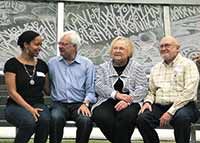
Figure 1: Regnier with his wife Linda and his first and last PhD students. From left to right: Nishi Rochelle (PhD 2011), Fred Regnier, Linda Regnier, and Peter Dunn (PhD 1973).
Major Scientific Contributions: Regnier is known as an innovator who has often bridged the gap between biochemistry and analytical science. He cites Wilson and Law as big influences in that regard. "They told me I should focus on method development, their rationale being that developing new, innovative, original methods always keeps one at the cutting edge," said Regnier. "'You will always be relevant,' they said."
Regnier took that advice to heart: Among his many accomplishments, he has received 45 patents related to the separation and detection of proteins and peptides. His work includes developing the first high-performance chromatography columns for size-exclusion chromatography (SEC), anion-exchange and cation-exchange chromatography, hydrophobic interaction chromatography (HIC), and macroporous reversed-phase chromatography separations of proteins; describing "footprint" retention models for ion-exchange chromatography (IEC), HIC, and reversed-phase chromatography of proteins; fabricating a variety of capillary and collocated monolith support structure capillary electrochromatography systems; and synthesizing multiple polymeric bonded phases for SEC, IEC, HIC, and affinity chromatography that enabled silica, titania, zirconia, alumina, and poly(styrene–divinylbenzene) supports to be used for protein separations; and the synthesis of gigaporous chromatographic media with enhanced mass transfer and pore diameters exceeding 400 nm.
When we asked Regnier's colleagues, past students, and friends about his biggest contributions to the field, the responses were as varied as his work. Barry Karger, the James L. Waters Chair in Analytical Chemistry and Director of the Barnett Institute at Northeastern University (Massachusetts, USA), feels Regnier's biggest contribution was the development of perfusion particles for preparative-scale separations of biopolymers. "These packings, developed over 25 years ago, are still widely used today for purification," he said.
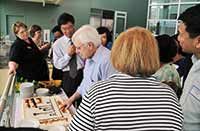
Figure 2: Regnier’s retirement party. Note the chromatogram on the cake.
Tim Schlabach, a marketing manager at Agilent Technologies and a former graduate student of Regnier's, agrees with Karger. "Critical advances in the fast separation of biomolecules including size-exclusion, ion-exchange, and perfusion chromatography were Regnier's biggest contributions," Schlabach said.
Joseph J. Kirkland, vice-president of R&D at Advanced Materials Technology Inc., points to Regnier's work characterizing biomolecules using HPLC. "Regnier was an early leader in recognizing the potential of HPLC for characterizing biomolecules and establishing effective research programmes to demonstrate this as a premier method," said Kirkland. "His contributions in this area have been enormously important in describing new science that has had a serious impact on improving health issues."
Wolfgang Lindner, a professor emeritus at the Institute of Analytical Chemistry at the University of Vienna (Vienna, Austria), believes that Regnier's knowledge of biochemistry, proteins, and biological systems led to his biggest contributions. "Regnier was always aware of the complexity of biological samples and systems and the great demand to have tools available to deconvolute the samples' complexity," said Lindner. He went on to explain that this awareness allowed Regnier to advance concepts of how LC can separate biomolecules, including peptides and large proteins. "This knowledge makes Regnier a very unique scientist indeed," he said. "There are not many colleagues in the world who have this spectrum of insights in the biochemical and separation science fields."
Karger echoed this sentiment. "Regnier combined his biochemical background with separation principles in very creative ways," he said. "He has made significant contributions to the advancement of separation science over this career."

Figure 3: 2013 ACS medal symposium. Back row, left to right: Ashraf G. Madian, Samir Julka, and Hamid Mirzaei. Front row, left to right: Mary Wirth, Fred Regnier, and Andy Alpert.
Tim Wehr, a staff scientist at Bio-Rad Laboratories, agreed that Regnier did groundbreaking work with biomolecules. "Fred is a pioneer in the field of HPLC of biomolecules, and the first large-pore chromatography columns designed specifically for protein separations were created in his lab," Wehr said.
Michael Dong, a senior scientist at Genentech, thinks that Regnier's greatest contributions were not just his work advancing the fundamentals of protein separations and microfluidics, but also "the idea of using analytical chemistry to solve the most important questions for mankind, which are mostly in biology".
Xiang Zhang, a professor of chemistry at the University of Louisville (Kentucky, USA), agrees with Dong. "Regnier's contribution to separation science is not only his development of chromatography systems for protein and small molecule separations, but also the application of these technologies to solve real-life problems," Zhang said.
Ira Krull, a professor emeritus of Northeastern University, points to the specifics of many of Regnier's contributions, such as the development of new stationary phases or instrumentation for HPLC separation of biopolymers, immobilized enzyme reactors, chip-based HPLC separations, and biopharmaceutical characterization. "Regnier has made countless contributions in separations, mostly in new and novel stationary phases, and instrumentation such as the Bio-Cad systems from PerSeptive Biosystems and other small firms that Regnier started." Krull is referring to one of the five companies related to separations and analytical chemistry that Regnier co-founded: Bioseparations, PerSeptive Biosystems, BG Medicine, Quadraspec, and Perfinity Biosciences.
Andrew Alpert, the president of PolyLC, Inc., and a former graduate student of Regnier's, also feels strongly about Regnier's work on the commercial side of analytical science. "Regnier ensured that his inventions became commercial products so that scientists everywhere would have ready access to them, and sometimes he started the companies needed to implement this," said Alpert. "That example particularly inspired me."
Alpert also points to Regnier's work adapting every mode of chromatography used for life-science separations from low-pressure media to HPLC media, adding that Regnier systematically worked out the requirements for a successful or optimal material in such applications. "In some cases, there was no precedent for this," Alpert said. "This set the agenda for everyone who has followed in that field."
Academic Contributions: Regnier was not only interested in developing products, however. He also focused on the development of his students. As an educator for more than 40 years, Regnier mentored more than 80 graduate students and more than 30 postdoctoral researchers. Edward Pfannkoch, the director of technology development in North America for Gerstel Inc., and a former graduate student of Regnier's, emphasizes the importance of this aspect of Regnier's career. "It is easy to cite Regnier's many contributions such as his fundamental work on coating wide-pore silica for HPLC packings for biological separations," he said. "However, I feel one of his biggest contributions is the training, guidance, and example he set for a whole generation of students that are now working in areas related to separation science."
Deena Krestel-Rickert, the owner of Pettec, LLC, and a previous graduate student of Regnier's, agrees with Pfannkoch. She explained that Regnier is an innovative thinker, a great speaker, very well-liked and respected, and extremely willing to help people both in their career and personal lives. "I was extremely fortunate to have been his student," Krestel-Rickert said. Schlabach also noted Regnier's willingness to help his students during both their academic and professional careers. "Regnier helped me on more than one occasion secure a position with a company," he said.
Work in Regnier's laboratory was both challenging and exciting for many of his students. Alpert came up with a great analogy: "Working with Regnier was like panning for gold. His numerous ideas and concepts were like a rushing river. It was the job of his graduate students and postdocs to reach in and grab the gold nuggets as the flow carried them by — that is, to figure out which ideas were both practical and worthwhile to implement, then work out a way to do so."
Zhang added that Regnier had a broad vision of science and was always excited and full of passion about his research. "Everyone who worked with Regnier knew that he was always the right person to talk with about research and the source to get encouragement."
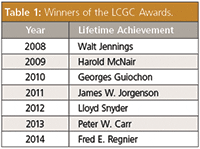
Table 1: Winners of the LCGC Awards.
Jim Pearson, a partner at Bioscience Advisors and a graduate student of Regnier's, says that Regnier never told him what experiment to do; instead he let Pearson explore and discussed the results afterwards. "This instilled a sense of scientific curiosity in me, because I could test my own ideas and bounce the results off Regnier," he said. Pearson's favourite example of this was in 1980 when he coated various porous silicas with an experimental reversed-phase coating containing an adamantyl "box-like" group at the end of the n-alkyl ligand. The goal was to see if peptide or protein selectivity could be enhanced, and the silicas had various pore diameters, ranging from 55 to 1000 Å. "To my surprise, the 330-Å diameter porous silica worked the best by far, and I was excited about my adamantyl 'box-like' ligand find," he said. "Regnier just smiled when he saw the data because he knew I [had] stumbled upon the understanding that the pore diameter effect is key for resolution." Regnier told Pearson to make an HPLC column with that 330-Å porous silica using a C8 ligand instead, which resulted in even better selectivity. "C8-coated 330-Å porous silica reversed-pha se columns soon became the universal standard for peptide and protein separations for the next 25 years," said Pearson.
Pfannkoch had a similar experience of being given independence in Regnier's laboratory, with his first real exposure to HPLC instrumentation. Pfannkoch explained that Regnier had an HPLC instrument that was also used to pack HPLC columns, and someone had precipitated buffer in the lines. "Regnier handed me some wrenches and a manual and said, 'Fix it,'" said Pfannkoch. "After that day I was never intimidated by analytical instrumentation."
Krestel-Rickert also said that Regnier taught her a lot about HPLC and GC and entrusted her with maintaining the HPLC system. What was much bigger than that, however, was that Regnier took her into his laboratory under a National Science Foundation grant on dog olfaction after she lost her major professor at Florida State and still had two years left to complete her PhD. "Regnier made a lot of things possible for me and always had my and all of his student's best interests and futures in mind," said Krestel-Rickert.
Pfannkoch summarized Regnier's role as an educator nicely. "Regnier's leadership, enthusiasm, example, and humility serve as a tremendous role model for all the best in science," he said.
The affection that Regnier's students have for him was recently demonstrated when many of them gathered together for a surprise party in honour of his retirement from Purdue University in May 2013. Jianming Lei, an analytical chemist at the office of Indiana State Chemist at Purdue University and a former graduate student of Regnier's, helped to organize the party and reached out to all of Regnier's former students and colleagues to create a book of congratulation letters, stories, and photos of Regnier throughout the years, titled Fred Regnier's Indy 500 of Chromatography and Other Stories.1 A few of those photos are included here. In the book, Regnier's wife, Linda, said that for Regnier, his students were "his life, his passion, and his pride and joy".
Contributions to the Field: Beyond his work in academia and commercial start-ups, Regnier has also contributed to the scientific community as a whole through his involvement in various boards, organizing committees, and journals. He has been on the editorial boards of 13 journals, including LCGC North America since its inception in 1983 as LC Magazine, and LCGC Europe. Regnier has also published more than 300 journal articles, two books, more than 30 book chapters, and more than 70 review papers.
Regnier explained that researchers in academia have a contract with society in which society provides money to examine scientific problems and, in turn, academics have an obligation to share what they find with society. "I view our relationship with the American taxpayer as a collaboration for which I am enormously grateful," he said. Regnier also described his role as peer-reviewer of manuscripts as "trying to help people improve the presentation of their work to society in the form of a publication".
Regnier was also one of the first organizers of the International Symposium on HPLC of Peptides, Proteins, and Polynucleotides (ISPPP) along with Wehr, Milton Hearn, Klaus Unger, and Jan-Christer Janson. The first meeting they organized was held in Washington, D.C., USA, in 1980. "The conference still takes place 34 years later, although none of the original committee members are involved with it," said Wehr. A photo of the 1982 organizing committee is shown in Figure 4.
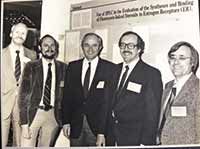
Figure 4: The chairmen at the 2nd ISPPP conference in December 1982, in Baltimore, Maryland, USA. From left to right: Jan-Christer Janson, Tim Wehr, Klaus Unger, Milton Hearn, and Fred Regnier.
Scientific Accolades: As one might expect, someone with this rich of a history in scientific achievements is sure to have received a number of awards from the community. Indeed, Regnier has received many accolades throughout his career. Some of the most notable awards he has received are the David B. Hime Award for Achievement in Chromatography (1982); the Stephen Dal Nogare Award for Achievements in Chromatography (1987); the ACS Award in Chromatography (1989); the Martin Gold Medal (1993); the Eastern Analytical Symposium Award for Achievements in Separation Science (1996); the CASSS Scientific Achievement Award (2000); the Golay Award (2001); and the Outstanding Commercialization Award, presented by Purdue University and the Central Indiana Corporate Partnership (2006) — just to name a few.
Personal Accounts: Regnier has made many friends during the course of his career. Many of these have fond memories and personal stories of their experiences with Regnier that they wanted to share.
Krestel-Rickert told us how she used to go running at the track with Regnier and would jokingly refer to him as "Mr. Popularity" because he could never make it around the track without someone wanting to talk to him. "If the person wasn't running, Regnier was so gracious that he would stop running and walk or stop to talk with them," she said. "So we kidded with him about whether he was going to the gym to run or to socialize."
Dong remembers when he invited Regnier to give an informal talk at a dinner event for the Chinese American Chromatography Association in 2012. There, Regnier said there should be an LC–MS instrument in every doctor's office so that doctors could make immediate diagnoses of diseases or treatment progression. Dong realized this could be possible if the front-end of a sample extraction could be automated so that the right biomarkers (often a protein isoform) could be isolated and determined. "Listening to him, it dawned on me that this could be the greatest contribution that an analytical chemist could make — to solve the great biology problems of today, such as those in disease diagnostics," said Dong.
Karger has been friends and colleagues with Regnier for more than 35 years and taught short courses with him in the 1980s on HPLC. He shared a light-hearted memory from the 1992 HPLC conference in Baltimore, Maryland, USA, where Regnier convinced well-known chromatographers (including Karger) to dress the way people dressed 500 years ago, in honour of the 500th anniversary of Columbus' discovery of America. "We stunned the attendees as we walked in to the conference to open the meeting," said Karger.
The winner of the LCGC 2014 Emerging Leader in Chromatography Award, André de Villiers, will be featured in an upcoming issue of The Column.
Reference
1. Fred Regnier's Indy 500 of Chromatography and Other Stories, available at: http://www.blurb.com/bookstore/invited/3531763/965fa935d167f1c23c7e4c18630aff06249d65b6?ce=blurb_ew&utm_source=widget (2013).
Megan L'Heureux is the managing editor of LCGC North America.
E-mail: mlheureux@advanstar.com
Website: www.chromatographyonline.com
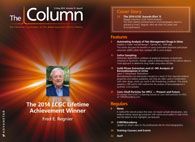
Detecting Hyper-Fast Chromatographic Peaks Using Ion Mobility Spectrometry
May 6th 2025Ion mobility spectrometers can detect trace compounds quickly, though they can face various issues with detecting certain peaks. University of Hannover scientists created a new system for resolving hyper-fast gas chromatography (GC) peaks.
University of Oklahoma and UC Davis Researchers Probe Lipidomic Profiles with RP-LC–HRMS/MS
May 6th 2025A joint study between the University of Oklahoma Health Sciences Center (Oklahoma City, Oklahoma) and the UC Davis West Coast Metabolomics Center (Davis, California) identified differentially regulated lipids in type 2 diabetes (T2D) and obesity through the application of reversed-phase liquid chromatography-accurate mass tandem mass spectrometry (RP-LC-accurate MS/MS).
Automated Sample Preparation (ISO 20122) for MOSH/MOAH in Seasoning Oils
May 6th 2025This work presents an Automated Sample Preparation procedure for MOSH/MOAH analysis of Seasoning Oils. We compare results from a manual epoxidation procedure compliant with DIN 16995 with results based on fully automated sample preparation (epoxidation and saponification) compliant with ISO 20122. In both cases, online clean-up via activated aluminum oxide (AlOx) are used to remove interfering n-alkanes from the MOSH fraction during the HPLC run. Automated data evaluation using a dedicated software (GERSTEL ChroMOH) is presented.

.png&w=3840&q=75)

.png&w=3840&q=75)



.png&w=3840&q=75)



.png&w=3840&q=75)








